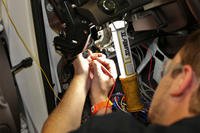Jump Links
- The Cadillac CTS Brings GM's Modern V6 Online For 2004, Reliability Problems Begin
- The Fix Finally Arrives For 2012 With the LFX
- A Clean New Design Arrives With the LGX for 2016
- The LF4 Version Powers The Fastest V6 Cadillacs With A Major Boost And Patented Charge Cooling
The year was 2004. You could still buy a Pontiac, a Honda Element, a Subaru Baja, a Mercury, or a Saturn Ion. Bluetooth hadn't quite joined the party yet, but if your car was fancy enough, it may have had iPod integration. The Honda Ridgeline was first shown as a concept. Chrysler had just launched the new LX-platformed series of rear-drive products that would take the HEMI V8 to the mainstream, and the last-ever car from Oldsmobile would roll off the assembly line as the brand was being wound down.
That last-ever car was a 2004 Oldsmobile Alero, with a 3.4-liter V6, 170 horsepower, 200 lb-ft of torque, and a four-speed automatic. The particular V6 engine under its hood had served GM well, powering a multitude of vehicles across numerous brands. It was part of a series of compact, narrow-angle V6 engines that also included 2.8, 3.1, 3.5 and 3.9-liter versions over the years. If you're wondering, the popular 3.8-liter V6 was also on the scene, though it came from a different engine family.

Oldsmobile
The guts of these engines were all developed decades earlier to be cheap, durable, and robust. Mission largely accomplished. Still, by the early 2000s, more stringent fuel economy and emissions standards were incoming, prompting automakers to develop new engines with new technologies. Automakers strived to build fewer individual engines, and instead looked to produce more engines with a 'one-size-fits-many' approach that would reduce manufacturing costs and complexity. Port fuel injection and pushrod valvetrains made for V6 engines that were cheap and reliable, but significant modernization was required to meet incoming new targets.
The solution for GM's next-generation products arrived alongside the departure of the Alero and GM's dated V6 engines in 2004. The resulting next-generation V6, initially dubbed the "high feature" V6 engine, had been designed to deliver competitive power output while rolling out aggressive fuel-saving measures that capitalized on the latest tech available at the time. Below, we'll look back at the evolution and iterations of one of the most popular V6 engines on the road, which even found its way into some of the fastest Cadillacs.
The Cadillac CTS Brings GM's Modern V6 Online For 2004, Reliability Problems Begin

Cadillac
What better place to launch a sophisticated new engine than under the hood of a sophisticated new luxury sedan? The first car to use GM's latest 3.6-liter compact V6 was the 2004 Cadillac CTS. At this point, the engine was called the 'LY7' and its main party trick was its lightweight construction and a quad-cam layout with variable valve timing and 24 valves, good for 255 horsepower and 252 lb-ft of torque while reducing fuel use versus previous V6 engines. This was a major advancement over past engines.
Before long, the new V6 would go on to power a wide range of incoming sedan and SUV products being launched into a highly competitive marketplace. The overhead cam design and compact dimensions of the high-feature V6 helped it achieve respectable mileage and power figures at launch in 2004, and laid the foundation for future updates. Still, the lengthy timing chain and associated hardware used to drive the complex new valvetrain would become a reliability liability for several years to follow. The owner's community has documented issues with timing chains that can prematurely wear and stretch, likely caused by the timing system's design and exacerbated by low-quality timing system parts and long oil change intervals.

Cadillac
By 2008, the original engine had been updated with a revolutionary new fuel delivery technology called Gasoline Direct Injection, which was widely proliferating the industry at the time as a means to help automakers meet tightening targets for fuel economy and emissions. Now dubbed the LLT, the direct-injection version of the next-generation V6 was the next major advancement. Now, fuel was blasted into the combustion chambers at extreme pressure, cooling the combustion chambers from the inside out with every injection event. Cooler combustion chambers can make more power, so this version of the engine boasted up to 302 horsepower with improved fuel consumption.
Still, timing chain problems persisted, and some owners reported excessive oil consumption and excessive carbon buildup on intake valves, a side effect of GDI in some engines. By now, the high-feature V6 was in a bit of hot water: while well-regarded by industry experts and impressive on the spec sheet, actual owners were taking to internet forums to share stories of still-ongoing timing chain and wear issues.
Read the full article on CarBuzz
This article originally appeared on CarBuzz and is republished here with permission.










